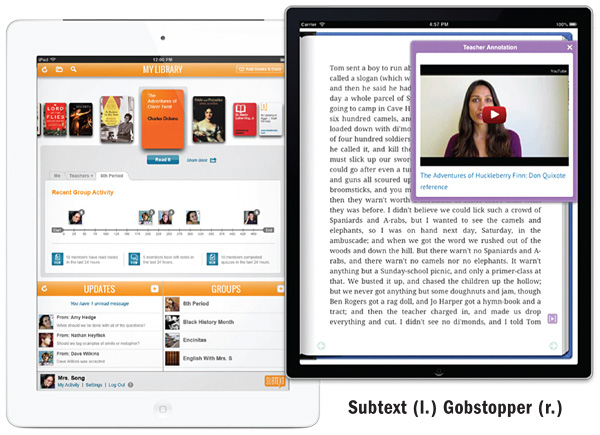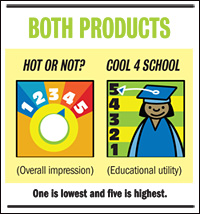
“If you think about math teachers, they’ve always been able to give assignments in which students are required to show their work. That makes it easy for them to check individual understanding, pretty much on a daily basis. English and humanities teachers who give extended reading assignments have never had that luxury. Instead, they’ve comparatively been flying blind, taking it on faith that most students have done the required reading, without knowing for sure, and moving along daily without solid evidence that kids are really ‘getting it.’”
That’s what Jason Singer, the CEO and founder of Gobstopper, told me was the central issue his product is designed to address: the challenge of ensuring that every student is meaningfully moving forward in a given reading assignment—and not just faking it. Gobstopper is an ereading application that also promotes ongoing feedback between teachers and kids. How does it do that? By giving teachers the ability to embed customized, Common-Core-based, formative assessments right into the etexts that they assign to their kids. Teachers can also insert scaffolded support in the form of annotations, Web links, or links to video-sharing sites. (Imagine the power a teacher would have if she posted videos that explained her own reactions to and interpretations of portions of a text.) Teachers can also add polls and quizzes, turning those assigned texts into ongoing class conversations and providing students, through Gobstopper’s reporting tools, with both qualitative feedback and quantitative snapshots about individual and group progress and comprehension.
 Just by glancing at their Gobstopper dashboards, teachers can see what percentage of kids in a specific class did their homework, how much time they spent reading, and what percentage of questions in a given Common Core standard such as “determining author intent” or “understanding historical context” their students answered correctly. Not only does that option eliminate the immense amount of time a typical humanities teacher wastes in class just trying to get a basic feel for who has actually completed and understood their assigned reading, but it cuts down on manual grading and attendant paperwork as well. Teachers needn’t necessarily enhance the etexts they assign from scratch, either. Instead they can select from among what Gobstopper calls “curriculets,” adding layers of ready-made content and assessments based on the skills they want to cover, and then tweaking the items to taste. For more information or to sign up and try Gobstopper, visit the welcome page for SLJ readers.
Just by glancing at their Gobstopper dashboards, teachers can see what percentage of kids in a specific class did their homework, how much time they spent reading, and what percentage of questions in a given Common Core standard such as “determining author intent” or “understanding historical context” their students answered correctly. Not only does that option eliminate the immense amount of time a typical humanities teacher wastes in class just trying to get a basic feel for who has actually completed and understood their assigned reading, but it cuts down on manual grading and attendant paperwork as well. Teachers needn’t necessarily enhance the etexts they assign from scratch, either. Instead they can select from among what Gobstopper calls “curriculets,” adding layers of ready-made content and assessments based on the skills they want to cover, and then tweaking the items to taste. For more information or to sign up and try Gobstopper, visit the welcome page for SLJ readers.
Subtext, launched a year ago and currently available as a free iPad and Edmodo app, is another application that doubles as a collaborative reading platform that focuses on Common Core skills. Subtext’s ereader has all the features—including text-to-speech capability, full-text searching, font selection, and a built-in dictionary—that you’d expect from a modern ereader app. Plus, in the right-hand margins of assigned selections, you’ll find teacher and student comments, links, embedded YouTube videos, quizzes, and polls, all indicated by familiar Facebook-like avatars that transform the normally solitary act of assigned reading into a friendly, ongoing social exchange that encourages students to “talk to the text” and to talk to one another. At the end of each chapter of the novels I previewed, students were asked—in Facebook’s thumbs up/thumbs down fashion—to rate the section. They were also invited to add a comment or prediction, start or join a discussion thread, or blog about the chapter they’d just finished reading.
Subtext works with any native or converted EPUB document, integrates with Google Books and Feedbooks, and Web pages can also be imported. According to Heidi Perry, Subtext’s marketing VP, lots of instructors choose to share assigned texts—and all of the ongoing classroom sidebars—on their interactive whiteboards during class time, not exactly “flipping” the typical ELA classroom, but certainly turning it inside out in a way that exposes the collective metacognitive underpinnings of the reading experience. Teachers can set up classes in Subtext from scratch or students can log into Subtext using their existing school-provided Google or Edmodo accounts. Subtext is working on creating an Android app and Web reader for the 2013-2014 school year. To find out more or to download the free app, visit www.subtext.com.
Both Gobstopper and Subtext are currently free at their most basic levels and when used with public domain texts. Neither has set a pricing plan for premium service levels that they’ll be offering in the future. Both companies, though, plan to monetize, in part by sharing profits on ebook sales. Subtext already partners with Google Books to offer convenient in-app ebook purchases that can be seamlessly delivered to entire classes, and Gobstopper is looking to have publishers on board by next fall.
Subtext and Gobstopper excite the English teacher and school librarian in me, opening up lots of new possibilities for collaboration and curation. And both applications completely blow the tired old book report options out of the water and instead encourage reading, analysis, and writing on a formative, rather than a summative, basis.
Plus, I can totally imagine using either app to remotely administer a summer reading program… preferably as I relax on a private island somewhere in the tropics. Sound good?


